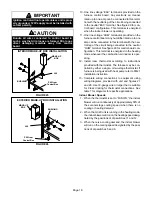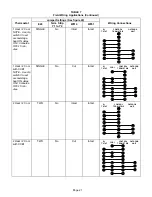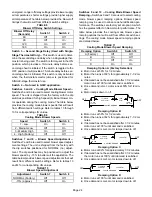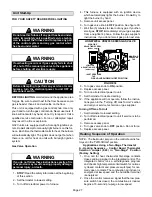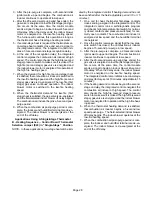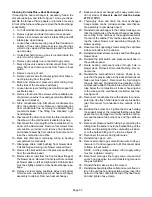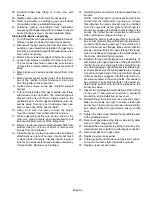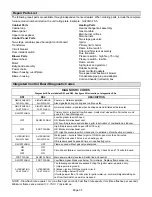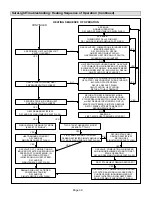
Page 31
Gas Pressure Adjustment
TABLE 17
Manifold Pressure (Outlet) in. w.c. (kPa)
No gas pressure adjustment is needed when operating at altitudes from 0 to 4500 ft. (0 to 8 m). See below for correct manifold pressures
for altitudes greater than 4500 ft. (1372 m) for natural and L.P. gas.
Manifold Pressure (outlet)
in. w.g. (kPa)
Model No.
0 to 4500 ft. (0 to 1372 m)
above sea level
4501 to 5500 ft.
(1373 to 1676 m)
above sea level
5501 to 6500 ft.
(1677 to 1981 m)
above sea level
6501 to 7500 ft.
(1982 to 2286 m)
above sea level
G32V-75 natural
3.5
3.5
3.5
3.5
G32V-100 natural
3 5 (0 87)
3 4 (0 85)
3 3 (0 82)
3 2 (0 80)
G32V-125 natural
3.5 (0.87)
3.4 (0.85)
3.3 (0.82)
3.2 (0.80)
G32V-75L.P.
7.5
7.5
7.5
7.5
G32V-100 L.P.
7.5 (1.90)
7.3 (1.81)
7.1 (1.80)
7.0 (1.74)
G32V-125 L.P.
7.5 (1.90)
7.3 (1.81)
7.1 (1.80)
7.0 (1.74)
Gas Flow
To check for proper gas flow to the combustion chamber,
determine the Btu (kW) input from the unit rating plate. DiĆ
vide this input rating by the Btu (kW) per cubic foot (cubic
meter) of available gas. The result is the required number
of cubic feet (cubic meter) per hour. Determine the flow of
gas through the gas meter for two minutes and multiply by
30 to get the hourly flow of gas.
Gas Pressure
1 - Check gas line pressure with unit firing at maximum
rate. Maintain a minimum of 4.5 in. w.c. (1.12 kPa) for
natural gas or 8.5 inches w.c. (2.11kPa) for LP/proĆ
pane gas.
2 - After line pressure has been checked and adjusted,
check high heat regulator pressure. See figure30 for
gas pressure adjustment screw location. High heat
manifold pressure for natural and LP/propane gas is
given in table 17.
Manifold Pressure Measurement & Adjustment
NOTE - Pressure test adaptor kit (10L34) is available
from Lennox to facilitate manifold pressure measureĆ
ment.
1 - Connect test gauge to outlet tap on gas valve.
2 - Disconnect pressure sensing hose from gas valve
and plug hose by covering opening with tape or
equivalent. Leave barbed fitting on valve open to atĆ
mosphere. See figure 31 for differential pressure
switch circuitry on 75 kBtuh models. Only 75 kBtuh
models are equipped with a second pressure switch.
Other models have single pressure switch.
3 - Start unit on high heat and allow 5 minutes for unit to
reach steady state.
4 - While waiting for the unit to stabilize, notice the
flame. Flame should be stable and should not lift
from burner. Natural gas should burn blue.
5 - After allowing unit to stabilize for 5 minutes, record
manifold pressure and compare to value given in
table 17.
NOTE - Shut unit off and remove manometer as soon as
an accurate reading has been obtained. Take care to re-
place pressure tap plug.
FIGURE 31
75 kBtuh DIFFERENTIAL PRESSURE SWITCH CIRCUITRY
BURNER
BOX
GAS
VALVE
SENSING
HOSE
COMBUSTION
AIR PRESSURE
SENSING HOSE
COMBUSTION
AIR BLOWER
BURNER
BOX
SENSING
HOSE
GAS
VALVE
PRESSURE
SWITCH
SENSING
HOSE
HOSE
BARB
HIGH HEAT
DIFFERENTIAL
PRESSURE
SWITCH
LEFT SIDE OF PRESSURE SWITCH = MORE NEGATIVE
RIGHT SIDE OF PRESSURE SWITCH = LESS NEGATIVE (Closer to Zero)
LOW HEAT
DIFFERENTIAL
PRESSURE
SWITCH
TEE
Honeywell PPS
Pressure Switch
Shown
NOTE - During this test procedure, the unit will be overĆ
firing:
Operate unit only long enough to obtain accurate
reading to prevent overheating heat exchanger.
Attempts to clock gas valve during this procedure will
be inaccurate. Measure gas flow rate only during
normal unit operation.
6 - When test is complete remove obstruction from hose
and return hose to gas valve barbed fitting.


